Unique Storytelling and Artistic Styling in Portrait of a Lady on Fire: A Distinct Combination
In the captivating film "Portrait of a Lady on Fire," director Céline Sciamma masterfully employs a unique blend of color, composition, silence, and sound to create an immersive and emotionally resonant cinematic experience.
The film's rich, naturalistic color palette is dominated by earthy tones, such as deep reds, greens, and blues, which evoke the 18th-century setting while symbolizing passion, restraint, and the natural world. The colors often reflect the emotional states of the characters, with the red of Héloïse's burning dress hinting at desire and transgression. The painterly quality of the visuals makes every frame resemble a classical painting, reinforcing the theme of art and observation.
Each shot in the film is meticulously framed to capture the intimacy and tension between the two women. The compositions often use symmetry and the relationship between foreground and background to show emotional distance or connection. Close-ups on faces, especially the eyes, heighten the unspoken emotions. The outdoor natural settings contrast with the confined interior spaces, mirroring the characters’ inner conflicts and longing. The film’s slow, deliberate pacing and composed shots allow the viewer to immerse in every nuance, making the experience akin to viewing a painting come to life.
Silence is a critical storytelling device in the film. Extended silent scenes emphasize nonverbal communication, the gaze, and the charged moments between the women. Silence allows tension and emotion to build organically, pushing the narrative beyond words into a visual and sensory experience. This creates intimacy and invites viewers to engage deeply with the characters’ feelings and the subtle dynamics of their relationship.
The film's soundtrack, which punctuates the narrative with moments of raw emotion and revelation, is carefully selected and used sparingly. Sparse orchestral arrangements underscore moments of connection and transformation, while traditional folk songs root the story in its historical context. The soundtrack serves as a powerful tool, engaging with the viewer and underscoring the film's emotional depth and symbolism.
Together, these elements—color, composition, silence, and sound—converge to create a film that is both visually poetic and emotionally powerful, where every frame conveys layers of meaning about desire, freedom, and the act of seeing and being seen. This meticulous visual and auditory style underlines the film’s core themes of connection and memory by crafting an immersive, painterly experience that is as much about what is unsaid as what is shown.
- The soundtrack of the film "Portrait of a Lady on Fire," carefully chosen and used sparingly, punctuates the narrative with moments of raw emotion and revelation.
- The film festival "Portrait of a Lady on Fire" was well-received for its unique blend of color, composition, silence, and sound, creating an immersive and emotionally resonant cinematic experience.
- In one particularly memorable scene, a close-up on the characters' eyes captures the unspoken emotions between them, underscoring the film's theme of art and observation.
- The rich animation in the film "Portrait of a Lady on Fire" brings the characters' inner conflicts and longing to life in a way that heightens the emotional resonance of the story.







